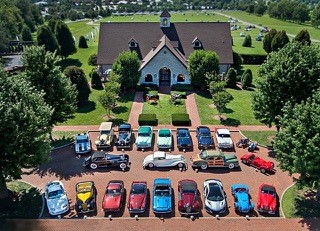To be invited or nominated to show your car at a Concours d’Elegance is like being invited to New York Fashion Week – only for cars. The Concours d’Elegance circuit is the highest form of car show in America. Picture cars you have never even dreamt of, shown off to the highest degree. Among these drool-worthy cars, is a car culture exclusive to the most exuberant enthusiasts.
The first thing that is required of a Concours d’Elegance is sending pictures of your car with some information about it. Depending on which Concours d’Elegance show you enter, they normally want anything from two to six pictures of your car. The pictures should capture the front and the back if two is all they are looking for. If more than two pictures are required, then they will ask for pictures of the front, back, interior, engine compartment, etc.
Once you have your pictures, you then must fill out forms or type up a brief history of your car, depending on which Concours show you are entering. If the show requires you to write a brief history of your car, make sure that you include the year, make, model and information that makes your car unique. The back story on your car can make a huge difference in whether your car gets picked to enter a Concours d’Elegance show or not. So, I would also suggest doing some research on your car because you could possibly have a car that someone famous once owned or it could be a rarity. Once all information and pictures have been turned in, then the waiting game begins.
If you get the acceptance letter from the Concours d’Elegance show, then CONGRATUALTIONS!!!! With being accepted into the Concours d’Elegance show, it is now time for you to check your car over for any issues that can cause point deductions during judging. Some things to consider when looking over your car: the condition of the paint job, working condition of all components, parts needing to be replaced, fluid leaks, correct decals applied and in the correct places, and finally, CLEAN your car! You should gather all your informational papers, photos of the build or other documentation that you have about your car that you may want to show the judges when they make their rounds on the show field. Review the current Concours Judging Guidelines, if available, for current general show and safety requirements.
When it comes time to go, you need to prepare a detailing bag because you will use these items throughout the show to keep your car “groomed”. Another suggestion I would make before leaving for a car show is to make sure your insurance will cover everything. I bring up the insurance because nothing would be a bigger disappointment if something were to happen and you did not have the coverage that you thought you had. You should make sure you have allotted yourself enough time for traveling, because incidents like traffic congestion, having a wreck (hopefully not, but you cannot control other people!), or if your car breaks down do happen and should be accounted for.
Another suggestion before leaving is to make sure you have packed the correct attire for the show. I say this because you do not want to present your car to a judge and have grease, holes, frays, etc., in your clothes. Not saying you must pull out a suit, but WORK clothes probably would not be the best attire for these shows. Keep in mind, most of these cars that are being presented have anything from five hundred thousand to one and half million dollars invested in them and looking like you just walked out of the garage is probably not the best look. Another option at some Concours is to dress in the era of your car. This adds a bit of fun “period ambience” to the event and there may even be awards for “Best Dressed”!
Upon the arrival to the car show, you should be ready for more work. The first thing you should do is get your car’s show packet. Even though your car was thoroughly cleaned and checked over for problems before leaving the garage, you still need to go around again and check for any issues. During your drive, your car can pick up things like dust, pollen, or any other particle that floats in the air. I also suggest checking all your wires, plugs, etc. because anything could have loosened up during the drive. Basically, you’re going to repeat your check over as you did before you left the garage because small things can cause your car to lose points. You would not want that, because we want that recognition!
During the show you will also have to maintain your car’s appearance because, just like while traveling, it will get dust, pollen, etc. on it and you will want your car looking superb when the judges come around. While reading Tim Suddard’s March 12, 2014 article in Classic Motorsports – Understanding the Concours Game, it suggested you should not over do the cleaning, for example make your “blacks black and every other contrast correct.” So, NO shiny black rubber!!! Remove any and all excess items from the interior and trunk of your car, including floor mats and display items.
You or a handler must be present at your car while the judging team is evaluating it. Be attentive to what the team is doing, stand back out of their way, and refrain from engaging them in conversation until you are asked. Be prepared to open the hood, trunk, and doors upon request. You may be asked to start your car and demonstrate that all of the lights, signals, and the horn work. If you are asked questions about your car, make sure you or your handler know all the ins and outs of your car because this can determine if you win your class or not. Another suggestion from the article in Classic Motorsports – Understanding the Concours Game is while talking with the judge, help the judge understand the process you went through restoring your car. After the judges leave you can take a deep breath and relax!
People will be walking around looking and may take notice of your car, so be prepared for questions from the curious bystanders. While you are cleaning and talking about your car, you should be aware of what is happening around it. Most people at a car show will have respect for the cars and its owner, but like most things in life you always have that one person! So, the best advice is to never leave your car by itself, and always have someone you can trust stand near to watch your car.
If your car wins in its class then CONGRATS, but it does not end there. You will drive your car upon the stage and received your award and take a picture (up a few paragraphs is why I suggested watching what you pack) and then you will drive to the winner’s circle. Once in the winner’s circle, you will then be judged again for Best in Show. While in the winner’s circle, the honorary, senior judges, and maybe a few more judges then walk around and look at each car to decide which vehicle they think deserves the award Best in Show. In addition to the Best in Show, there are other awards that each Concours d’Elegance offers as well.
The end of the show preparation is not really all that complicated. You must pack up all your stuff you brought to the show and be off the show field by a certain time. With a mass amount of people all trying to achieve the same thing at the same time, it can get frantic. You will have to be aware of your surroundings and make sure nothing happens to your car while in the escaping process. Once your car is loaded up, then you will be heading back to your hotel.
Upon the arrival at the hotel, you may have to find a space that is big and safe enough for your truck and trailer to park. With some hotels, their parking lots can be tight and having to park your truck and trailer and find a safe place from those “bad-drivers” can be a challenge in itself. A Concours d’Elegance stands as the epitome of a car show, but at its heart it is still just that – a car show. If you are blessed enough to be invited, enjoy the stress of preparing, talk to the other entrants and observers, and overall, just have a good time. Car people are car people, this is just major leagues.


